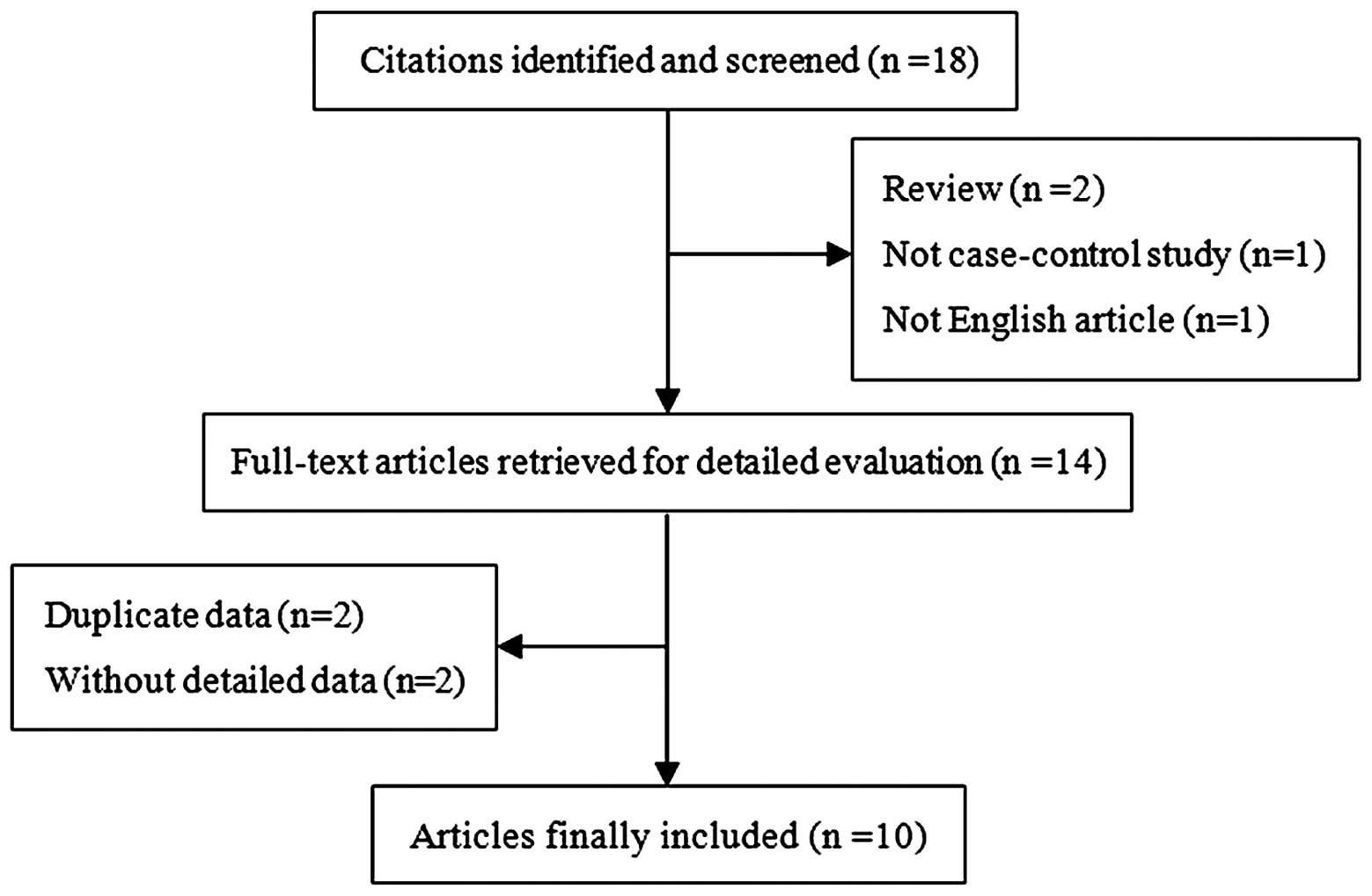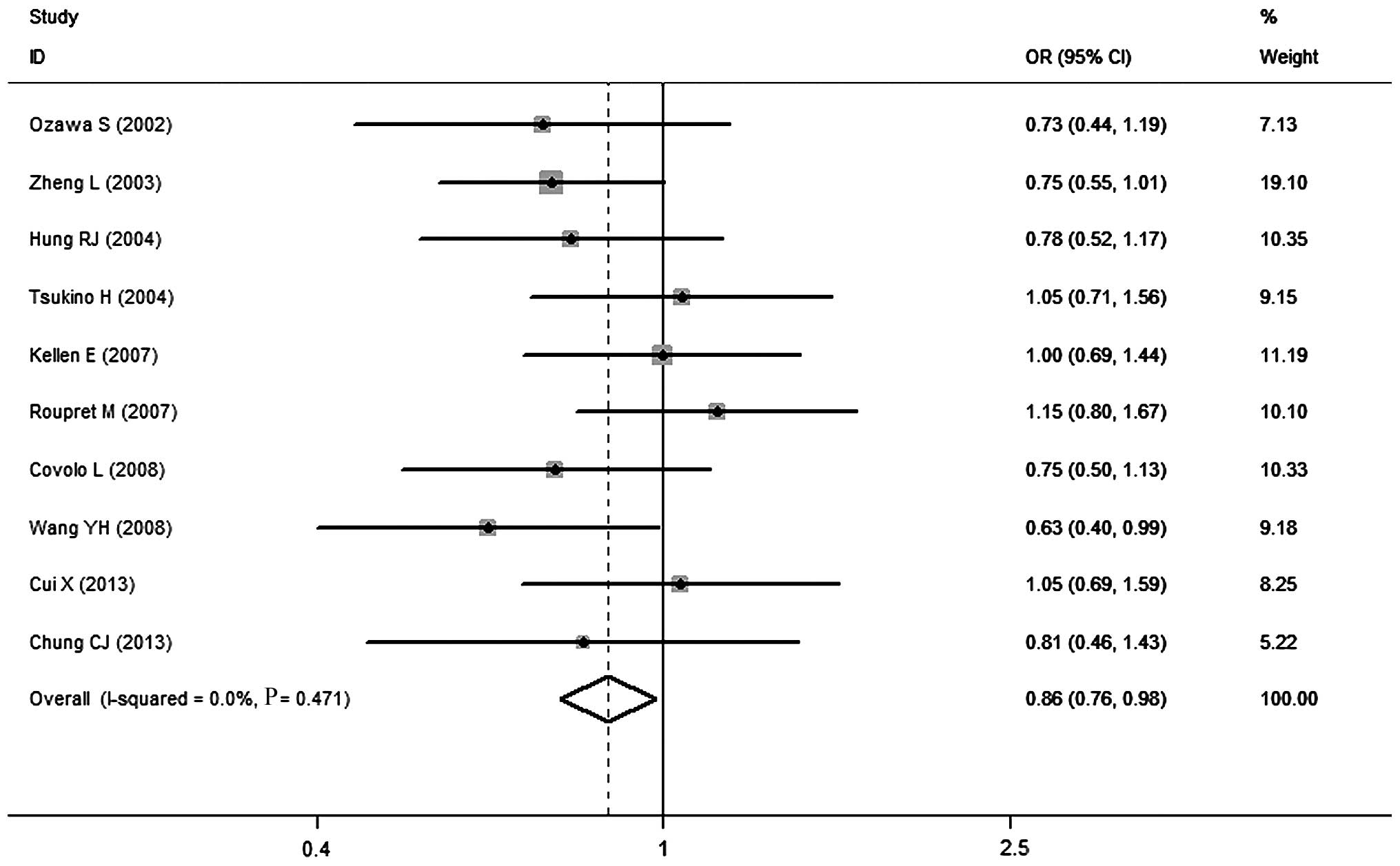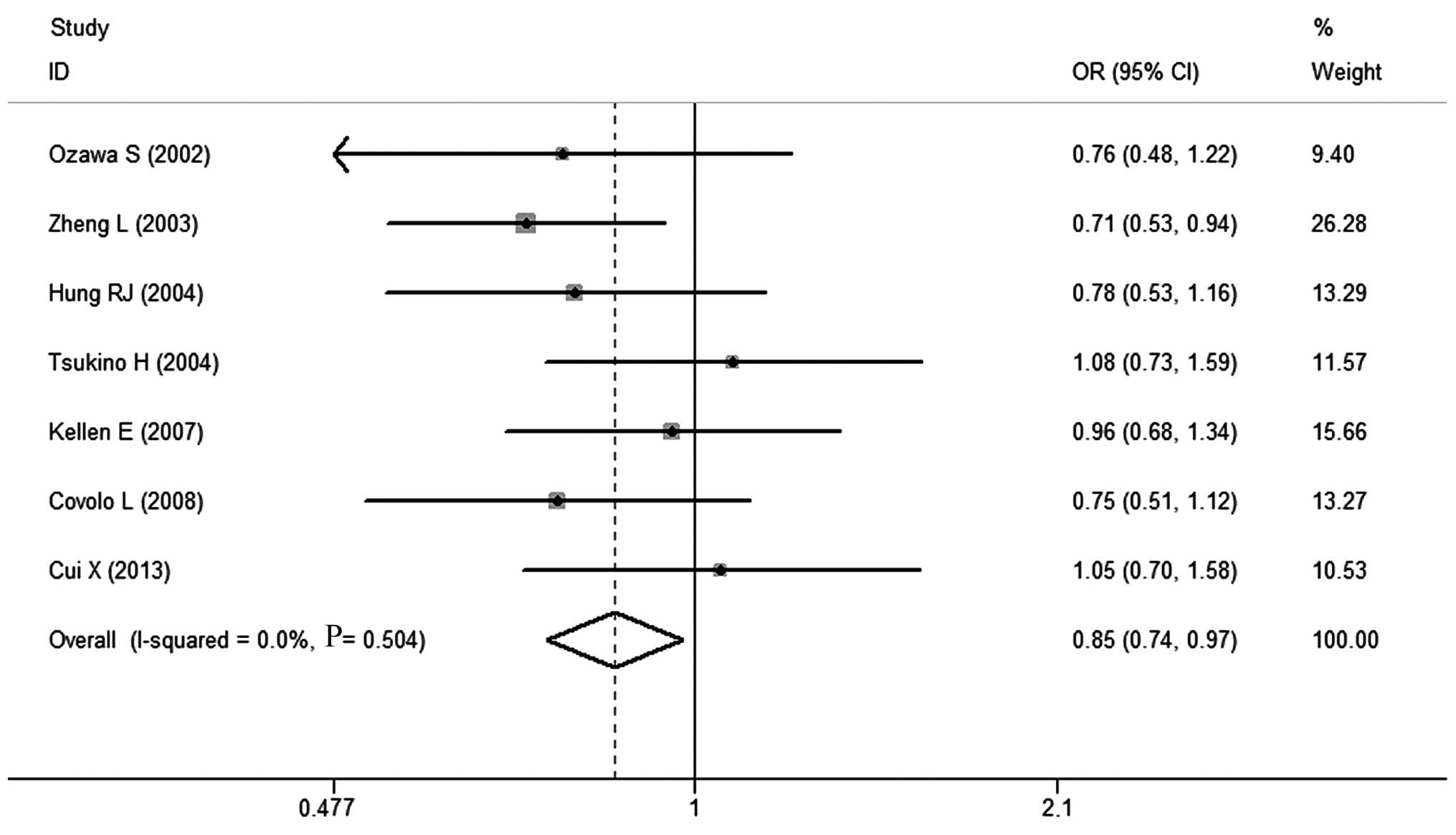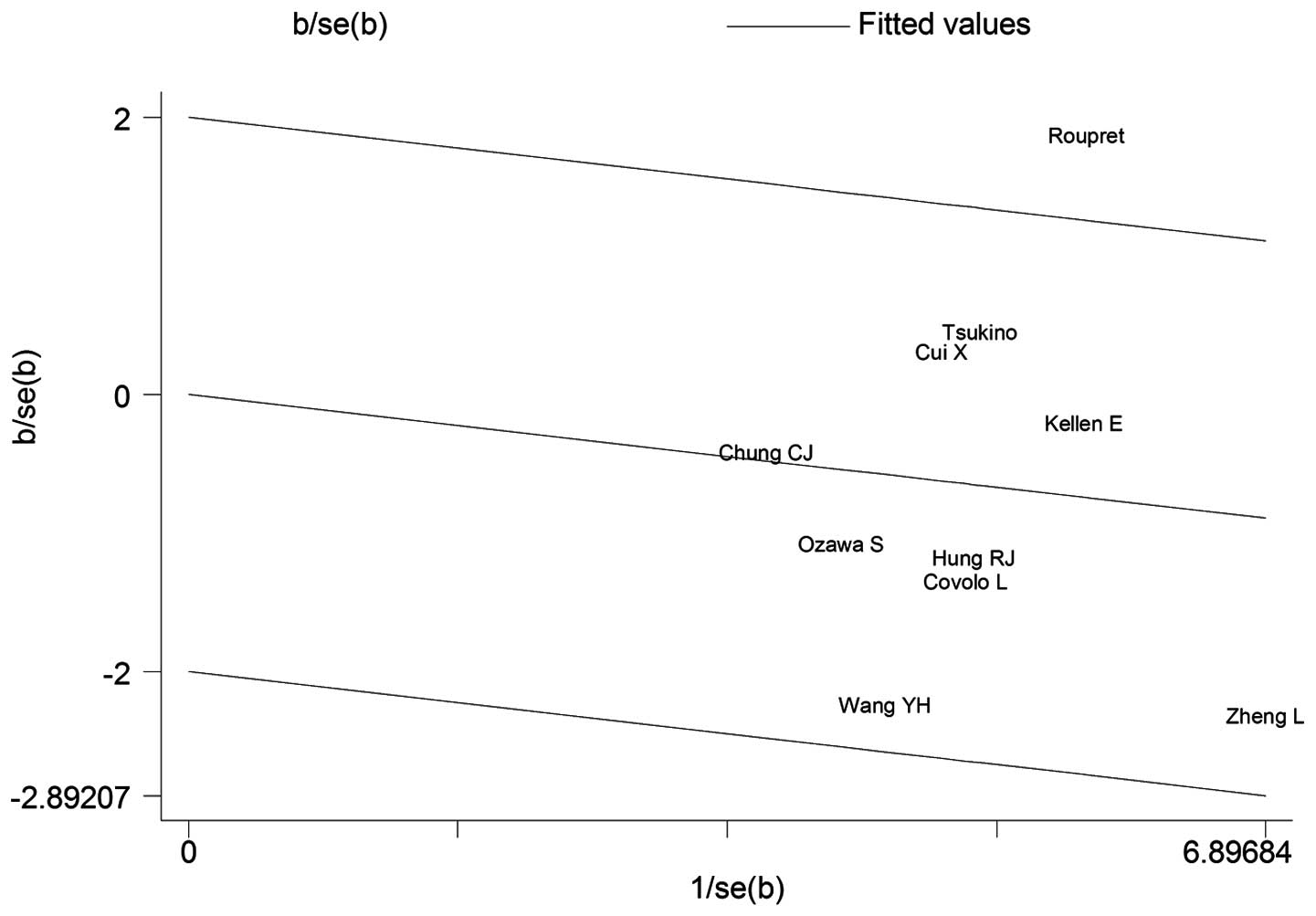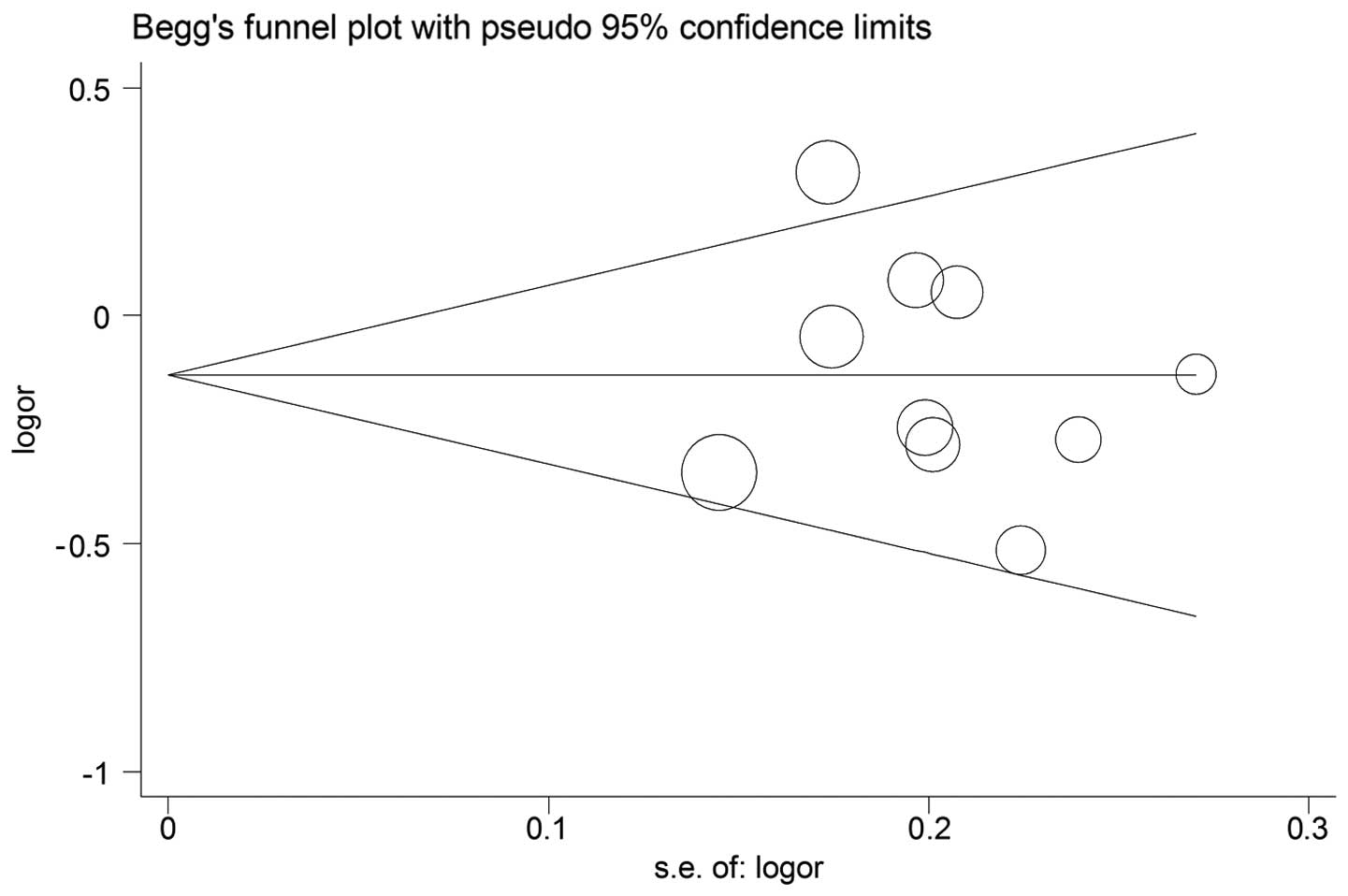Quantitative analysis of the association between sulfotransferase isoform 1A1 polymorphism and risk of urothelial carcinoma
- Authors:
- Published online on: September 1, 2014 https://doi.org/10.3892/mco.2014.406
- Pages: 93-100
Abstract
Introduction
Urothelial carcinoma (UC) is a common genitourinary disease, which represents the fourth most common malignancy worldwide. It originates exclusively from the urothelium and may occur in the lower urinary tract (bladder and urethra) or the upper urinary tract (renal pelvis and ureter) (1,2). Bladder cancer (BC) is the most common type of UC, whereas upper urinary tract urothelial carcinoma (UTUC) is relatively uncommon and accounts for only 5–10% of all UCs (3). To date, the pathogenesis of UC has not been fully elucidated. Known risk factors include cigarette smoking, exposure to workplace-related chemicals and intake of drugs, such as phenacetine, chlornaphrazine and cyclophosphamide (4,5).
Sulfotransferases (SULT), a family of multifunctional enzymes, transfer the sulfo group from the cofactor 5′-phosphoadenosine-3′-phosphosulfate to the nucleophilic sites of their substrates (6). It was previously demonstrated that SULTs are key contributors to the conjugation and removal of several phenolic xenobiotics and a variety of endogenous compounds, including neurotransmitters and steroid hormones (7). At least 11 different SULT enzymes were recently identified in humans. Among these, sulfotransferase isoform 1A1 (SULT1A1) appears to be a key phenol SULT, as it has been detected in a wide range of human tissues, including liver, lung and kidney (8).
The SULT1A1 gene, located on chromosome 16p12.1-p11.2, contains several genetic polymorphisms that possibly affect individual susceptibility to cancer (9). A functional polymorphism in exon 7 of the SULT1A1 gene, with a G→A substitution, results in a change in the amino acid sequence from arginine to histidine, leading to a decrease in enzymatic activity and variable rates of activation or detoxification of procarcinogens (10,11). Carcinogenic aromatic amines, such as 4-aminobiphenyl, which is contained in tobacco smoke, are one of the causal factors of UC. Furthermore, SULT1A1 has been shown to efficiently catalyze the metabolic activation of an N-hydroxyderivative of 4-aminobiphenyl (12). Therefore, it is hypothesized that the Arg213His polymorphism in the SULT1A1 gene may be closely associated with high susceptibility to UC.
To the best of our knowledge, several molecular epidemiological studies have investigated the association between the Arg213His polymorphism and UC risk in diverse populations. However, the results of those studies were inconsistent or even contradictory and, to date, no study has conducted a quantitative assessment to confirm this association. Therefore, we performed a meta-analysis of all eligible studies to derive a more precise estimation of the association between the Arg213His polymorphism and UC risk.
Materials and methods
Identification of eligible studies
A comprehensive literature search was performed through the PubMed, Medline, Embase and Web of Science databases for relevant published articles (the last search update was January 31, 2014) using the key words ‘SULT1A1’, ‘polymorphism’, ‘variation’, or ‘mutation’ and ‘bladder’, or ‘urothelial’ in combination with ‘cancer’, ‘tumor’ or ‘carcinoma’. The search was limited to human studies and English language publications. Additional studies were identified by hand, searching the reference lists of original and review articles.
Inclusion and exclusion criteria
The included studies were required to meet the following criteria: The studies i) used a case-control design, ii) evaluated the SULT1A1 Arg213His polymorphism and the risk of UC and iii) the genotype distribution of the polymorphism in cases and controls was described in detail and the results were expressed as odds ratio (OR) and corresponding 95% confidence interval (CI). The major exclusion criteria were as follows: i) Study not investigating cancer, ii) review articles, iii) only case population and iv) duplicate of previous publication.
Data extraction
Information was carefully extracted from all eligible studies independently by two investigators according to the inclusion criteria listed above. In case of conflicting evaluations, a consensus was reached through discussion. The following information was collected from each study: first author's name, year of publication, ethnicity, country of origin, cancer type, genotyping method, source of control groups (population- or hospital-based) and deviation from the Hardy-Weinberg equilibrium (HWE) of the control group. Different ethnic descents were categorized as Asian, Caucasian, or mixed (composed of different ethnic groups). Cancer types were divided into BC, UTUC or mixed (including different types of UC) due to anatomic differences. The corresponding and first authors of the published studies were contacted via e-mail in case original data were not provided.
Statistical analysis
Crude ORs with their corresponding 95% CIs were used to assess the strength of the association between the SULT1A1 Arg213His polymorphism and UC risk. The pooled ORs were estimated for the homozygote (A/A vs. G/G), heterozygote (G/A vs. G/G), dominant (G/A+A/A vs. G/G) and recessive (A/A vs. G/G+G/A) models. Between-study heterogeneity was assessed with the Chi-square-based Q test and heterogeneity was considered statistically significant when P<0.10 (13). The pooled OR estimate of each study was calculated with the fixed-effects [the Mantel-Haenszel method (14)] or the random-effects models [the DerSimonian and Laird method (15)]. The fixed-effects model was adopted when the studies were found to be homogeneous (Q test P>0.10). Otherwise, the random-effects model was applied. To further investigate possible sources of between-study heterogeneity, a meta-regression analysis was performed and a Galbraith plot was created. In addition to the comparison among all subjects, we also conducted stratification analyses by ethnicity, cancer type and source of controls. Sensitivity analyses were performed to assess the stability of the results, namely, a single study in the meta-analysis was deleted each time to reflect the effect of the individual data set on the pooled OR. Begg's funnel plot and Egger's linear regression test were used to assess publication bias. Moreover, departure from HWE in controls was assessed by the Chi-square test for goodness of fit and a P<0.05 was considered as a significant disequilibrium. All the statistical analyses were performed with Stata software, version 12.1 (StataCorp LP, College Station, TX, USA), using two-sided P-values.
Results
Study characteristics
According to the abovementioned inclusion criteria, we identified 10 independent studies (1,8,16–23), including a total of 2,495 cases and 2,905 controls (Fig. 1). These 10 independent studies consisted of 5 Asian, 4 Caucasian and 1 mixed population. The controls (8 hospital- and 2 population-based) were mainly matched by gender and age. The cancers were histologically or pathologically confirmed in all 10 studies. There were 5 studies on BC, 4 on mixed cancers (including different types of UC, although the majority of cases were BC) and 1 on UTUC. In addition, the distribution of genotypes in the controls in all the studies was consistent with HWE, except for 2 studies. The main characteristics of all the eligible studies are summarized in Table I.
Meta-analysis
The associations between the Arg213His polymorphism in SULT1A1 and the risk of UC are summarized in Table II. Overall, a significant association was observed between this polymorphism and decreased UC risk in the heterozygote model (OR=0.86, 95% CI: 0.76–0.98; Fig. 2), while no obvious association was found in the homozygote, recessive and dominant models. However, there was significant between-study heterogeneity; therefore, we performed subgroup analyses. Through stratified analyses, the heterogeneity of the subgroup was significantly reduced. In the subgroup analysis by ethnicity, no significant association was observed, except for the mixed population in the homozygote (OR=0.58, 95% CI: 0.35–0.94) and the dominant (OR=0.71, 95% CI: 0.53–0.94) models. A stratified analysis was also performed by source of controls. We demonstrated that the SULT1A1 Arg213His polymorphism was significantly associated with a decreased UC risk in population-based controls under the dominant model (OR=0.67, 95% CI: 0.46–0.97). When restricting the analysis to cancer type, the results indicated that individuals with the G/G genotype had a significantly higher BC risk in the heterozygote (OR=0.84, 95% CI: 0.71–0.99), the homozygote (OR=0.71, 95% CI: 0.52–0.97) and the dominant (OR=0.82, 95% CI: 0.70–0.96) models. Of note, a conflicting association was found in the UTUC subgroup under the homozygote (OR=2.18, 95% CI: 1.28–3.69) and the recessive (OR=2.05, 95% CI: 1.24–3.38) models. Moreover, the association between the SULT1A1 Arg213His polymorphism and UC risk was evaluated according to different smoking status. The stratification by smoking status revealed that the Arg213His polymorphism was associated with a decreased risk of UC in non-smokers (OR=0.70, 95% CI: 0.53–0.92) but not in smokers (OR=0.85, 95% CI: 0.70–1.03) under the dominant model (Table III).
BC is the most common type of UC. We also identified the association between the Arg213His polymorphism and BC risk. In two Japanese studies (14,15), the majority of cases were BC patients. Herein, these two case groups may be considered as two groups of BC patients by approximation. Namely, we considered that these two case groups may represent the characteristics of BC patients. As shown in Table IV, a significantly decreased risk of BC was associated with the SULT1A1 G/G polymorphism for the heterozygote (OR=0.88, 95% CI: 0.74–0.99) and the dominant (OR=0.85, 95% CI: 0.74–0.97) models (Fig. 3). In the subgroup analysis by ethnicity, we did not observe any significant association between this polymorphism and BC risk among Asians and Caucasians in any of the genetic models. In the stratified analysis by source of controls, a significant association was found with population-based source in the homozygote model (OR=0.67, 95% CI: 0.46–0.97). These results were similar to those obtained when restricting the analysis to cancer type.
Test for heterogeneity
When we included all the eligible articles, there was significant heterogeneity for heterozygote (P=0.046) and dominant (P=0.089) model comparisons. Subsequently, we used a meta-regression analysis to investigate the source of heterogeneity by ethnicity, cancer type and source of controls. Finally, we found that the cancer type (τ2=0, P=0.008) contributed to significantly altered heterogeneity, which may account for 100% source of heterogeneity. In addition, a Galbraith plot was also created and the result demonstrated that the study of Roupret et al (16) was the source of heterogeneity (Fig. 4). When 7 studies on BC were included, no heterogeneity was observed in any of the genetic models.
Sensitivity analyses
We next conducted a leave-one-out sensitivity analysis to determine whether a particular study or studies would result in heterogeneity. It was demonstrated that the study of Roupret et al (16) may qualitatively alter the pooled ORs for the Arg213His polymorphism. Following exclusion of this study, the degree of heterogeneity significantly decreased. The same method was used to assess the stability of our results when we included 7 articles on BC. Consequently, the sensitivity analysis confirmed that the results of this meta-analysis were statistically robust.
Publication bias
Begg's funnel plot and Egger's test were performed to assess the publication bias. The shape of funnel plots did not reveal any evidence of obvious asymmetry in any of the comparison models (Fig. 5) and the results of the Begg's test did not show any evidence of publication bias. Similar results were obtained when we investigated the association between Arg213His polymorphism and risk of BC.
Discussion
SULT1A1 is a phase II detoxification enzyme, which has the ability to sulphate phenolic and steroid compounds (24). SULT1A1 activity varies several fold among individuals and exhibits a strong familial segregation, suggesting that genetic factors play a significant role in determining the enzymatic activity of SULT1A1 (25). A common single-nucleotide polymorphism in the coding region of SULT1A1 (Arg213His) has been identified and was reported to be associated with decreased platelet enzymatic activity and thermostability. This mutation may affect an individual's capacity to efficiently sulfate endogenous compounds, drugs and xenobiotics and, consequently, increase an individual's susceptibility to cancer (26). To date, a number of case-control studies have been conducted to investigate the association of this polymorphism with UC in humans. Unfortunately, the link remains unclear and ambiguous. To address this issue, we conducted the present meta-analysis based on 10 studies, including a total of 2,495 cases and 2,905 controls. A meta-analysis is a powerful tool, as it may provide more reliable results compared to a single study and reduce random error (27). Finally, our meta-analysis indicated that the Arg213His polymorphism in the SULT1A1 gene may contribute to a significant decrease in the overall risk of BC. However, compelling evidence on a consistent association in UC is currently lacking.
UC is a highly aggressive malignancy that is associated with significant morbidity and mortality. UC may be mainly classified as UTUC and BC, according to the anatomical location. We observed that individuals with the A/A genotype were possibly associated with a decreased risk of UC when all the eligible studies were pooled into the meta-analysis. As anatomical differences may affect the results from meta-analyses, we also limited our analyses to BC and UTUC. A total of 4 studies in our meta-analysis enrolled cases including BC as well as UTUC patients. We were unable to consult the authors for the detailed original data of their studies; however, through careful reading, we found that the majority of the cases in 2 Japanese studies (16,17) were BC patients. Thus, we decided to combine these 2 studies with 5 studies (19–23) that only included BC patients, to probe the association between the Arg213His polymorphism and BC. Consequently, our findings demonstrated that the Arg213His polymorphism was significantly associated with a decreased risk of BC. To eliminate the potential effect of UTUC cases and determine the association more precisely, we excluded the 2 Japanese studies in the subgroup analysis by cancer type. As expected, the results were in accordance with the abovementioned observations. Of note, a contradictory and interesting association was observed in the UTUC subgroup. Our results suggested that individuals with the A/A genotype had a higher risk of UTUC compared to subjects carrying the wild genotype, raising the question of why our results on UTUC did not confirm the protective effect of the Arg213His polymorphism with respect to BC risk. This discrepancy may be attributed to the differences between BC and UTUC. Although UTUC and BC both originate from the urothelium and may share certain risk factors or molecular disruption pathways, each has its own distinct characteristics. In comparison to UC of the bladder, primary UTUCs are less common, representing only 5% of all UCs and <10% of renal tumors (28). The annual incidence of UTUC is low compared to that of BC. Catto et al (29,30) provided evidence that the extent of the mutator and methylator phenotypes in UC differed with tumor location and suggested that carcinogens may affect the urinary tract in different ways. Furthermore, several studies demonstrated that patients with UTUC have a higher risk, compared to those with BC, for hereditary non-polyposis colorectal cancer and microsatellite instability is more common in UTUC compared to BC (31,32). Green et al (33) described UTUC and BC as disparate twins in their recent review and revealed that there were practical, anatomical, biological and molecular differences between these two types of cancer. In addition, the study of Liang et al (34) strongly suggested that the urothelia of the bladder and upper urinary tract represent two separate cell lineages and are most likely maintained by distinct stem cell populations. Therefore, we hypothesized that genetic polymorphisms of enzymes metabolizing carcinogens may yield products of different activity and lead to opposite cancer risks. In other words, histologically identical tumors may arise through different molecular mechanisms. In two Japanese studies, although the cases included BC as well as UTUC patients, the sum of the UTUC patients was inadequate to have statistical power affecting the overall results. It is noteworthy that certain other factors may also result in this discrepancy. For UTUC, there was only one study included in the analysis with limited sample sizes and the subjects were all French. In addition, we found that the DNA of the cases in this UTUC study was extracted from tissues, whereas the DNA in the majority of the other studies was extracted from the blood. It is widely accepted that DNA from white blood cells rather than tissue should be used for determining genetic polymorphisms, as loss of heterozygosity has been noted in exfoliated cells (35). Taken together, a relatively small sample size, differences in country and race and diverse methods were likely to affect our results. Therefore, a larger sample size and a higher number of articles are required to verify the association between the Arg213His polymorphism and UTUC.
Different ethnicities may have disparate genetic backgrounds, which affect the association between polymorphism and cancer susceptibility. We performed a stratified analysis by ethnicity; however, we were unable to identify any positive association among Asians and Caucasians, whether 10 or 7 articles were included in the analyses. The number of subjects was relatively limited, without sufficient statistical power to investigate the true association. Furthermore, in view of the diversity of possible comparisons and the unavoidable flexibility in selecting and defining the correlations, the associations may not be necessarily reliable. For example, selection bias, matching criteria, misclassifications on disease status and genotyping may play a role. In addition, we mentioned that only 5 studies investigated Asian populations and only 4 studies included Caucasian populations. Therefore, larger-scale studies and combined analysis are required to further investigate ethnic differences in the effect of the Arg213His polymorphism on the risk of UC. In the subgroup analysis by source of controls, a significantly decreased UC risk was observed among studies using population-based controls. Some bias may exist in hospital-based studies, as such controls may represent a sample of an indistinct reference population instead of the general population, particularly when the genotypes investigated were associated with the condition of the hospital-based controls. Thus, a proper and representative cancer-free control sample is crucial for reducing bias in such genotype association studies.
Thus far, the single most important risk factor in the development of UC is exposure to cigarette smoke. It is estimated that ~80% of all UC may be attributed to cigarette smoking (34). It was previously reported that smoking increases the risk of developing BC and UTUC by as high as 4- and 6-fold, respectively (37). Arylamines, which are found in tobacco smoke, proceed via a two-step pathway involving cytochrome P450 1A2-catalyzed N-hydroxylation followed by an O-esterification step catalyzed by N-acetyltransferases (NATs) and/or SULTs. As a consequence of these reactions, in UCs, the aryl nitrenium ions generated from N-hydroxylamines are considered to be the ultimate reactive intermediates responsible for carcinogenic activity. In this study, we performed a stratified analysis by smoking status based on 6 studies that presented detailed data of smoking status and drew the conclusion that the Arg213His polymorphism was associated with a decreased risk of UC in non-smokers, but not in smokers. A possible explanation is that the association between this polymorphism and the decreased risk of UC may be masked by the overwhelming accumulated exposure to tobacco carcinogens, so that the association is more evident in non-smokers. In addition, passive smoking should be taken into consideration. Non-smokers may be exposed to second-hand smoking. When tobacco smoke is inhaled, some of the carcinogens are absorbed through the lungs into the blood. However, these results require confirmation by further large-scale studies.
The significance of heterogeneity, which may affect the results of this meta-analysis, must be addressed. Obvious heterogeneity between studies was observed when we included all eligible studies. Consistently, through meta-regression analysis and creation of a Galbraith plot, we observed that the study of Roupret et al (18), which was the only study that included UTUC patients as case group, was the main source of heterogeneity. The degree of heterogeneity significantly decreased after this study was excluded. The most likely interpretation may be the differences between BC and UTUC, as mentioned above. In addition, the differences in the pathological stages of the patients and the genotyping methods, such as Taqman and PCR-RFLP, may also lead to heterogeneity.
Furthermore, despite the overall robust statistical evidence generated through this analysis, certain limitations were identified. First, our results were based on unadjusted estimates, while a more precise analysis should be conducted if all individual raw data were available, which would allow for adjustment by other covariates, including age, gender, alcohol consumption, cigarette consumption and other lifestyle habits. Second, only studies that were indexed by the selected databases were included for the meta-analysis and some relevant published studies or unpublished studies with null results were missed, which may have biased our results. Third, UC is a multifactorial disease that results from complex interactions between several genetic and environmental factors, suggesting that there is not a single genetic or environmental factor significantly affecting the susceptibility to UC. Thus, the combined effects of different gene polymorphisms should be further analyzed. In our meta-analysis, as SULT1A1 and NAT2 are both involved in the metabolism of arylamines and NAT2 has been reported to play a role in carcinogenesis, we aimed to discuss the combined effects of SULT1A1 and NAT2 genetic polymorphisms. However, we were unable to do so, as only 3 studies provided detailed data of these two genes. Fourth, to the best of our knowledge, this is the first meta-analysis regarding the comprehensive assessment of the association between the Arg213His polymorphism and the risk of UC. Thus, the number of published studies was not sufficient for a comprehensive analysis, particularly for UTUC. Therefore, more studies with larger sample sizes and detailed information are required. In addition, the patients exhibited different histological stages and grades or other coexisting conditions, which may have affected our results. Furthermore, other pathological types of urinary BC should be considered, which may be an interference factor.
In conclusion, the results from the present meta-analysis indicated an association between the Arg213His polymorphism and a decreased risk of BC. However, there was insufficient evidence to support a consistent association between this polymorphism and UC, partly due to the differences between BC and UTUC. To advance the understanding of this association, the following recommendations have been made: First, decrease false-positive and -negative results through stratifying large samples by age, gender, dietary habits, lifestyle and ethnicity. Second, histopathological and clinical data may be used to subclassify the type and stage of UC to obtain a more homogeneous population for the analysis. Thirdly, given the fact that UC is a type of polygenic disorder, the combined effects of different gene polymorphisms require further analysis. Finally, more case-control studies or updated meta-analyses should be conducted to elucidate the possible roles of the Arg213His polymorphism in the etiology of UC.
References
|
Chung CJ, Huang CY, Pu YS, Shiue HS, Su CT and Hsueh YM: The effect of cigarette smoke and arsenic exposure on urothelial carcinoma risk is modified by glutathione S-transferase M1 gene null genotype. Toxicol Appl Pharmacol. 266:254–259. 2013. View Article : Google Scholar : PubMed/NCBI | |
|
Milenkovic-Petronic D, Milojevic B, Djokic M, Sipetic-Grujicic S, Milojevic IG, Bumbasirevic U and Dzamic Z: The impact of tumor size on outcomes in patients with upper urinary tract urothelial carcinoma. Int Urol Nephrol. 46:563–569. 2014. View Article : Google Scholar : PubMed/NCBI | |
|
Tanaka N, Kikuchi E, Kanao K, et al: The predictive value of positive urine cytology for outcomes following radical nephroureterectomy in patients with primary upper tract urothelial carcinoma: a multi-institutional study. Urol Oncol. 32(48): e19–26. 2014. View Article : Google Scholar | |
|
Peng Q, Mo C, Tang W, et al: DNA repair gene XRCC3 polymorphisms and bladder cancer risk: a meta-analysis. Tumour Biol. 35:1933–1944. 2014. View Article : Google Scholar : PubMed/NCBI | |
|
Ross JS, Wang K, Al-Rohil RN, et al: Advanced urothelial carcinoma: next-generation sequencing reveals diverse genomic alterations and targets of therapy. Mod Pathol. 27:271–280. 2014. View Article : Google Scholar : PubMed/NCBI | |
|
Glatt H and Meinl W: Pharmacogenetics of soluble sulfotransferases (SULTs). Naunyn Schmiedebergs Arch Pharmacol. 369:55–68. 2004. View Article : Google Scholar : PubMed/NCBI | |
|
Ginsberg G, Guyton K, Johns D, et al: Genetic polymorphism in metabolism and host defense enzymes: implications for human health risk assessment. Crit Rev Toxicol. 40:575–619. 2010. View Article : Google Scholar : PubMed/NCBI | |
|
Wang YH, Juang GD, Hwang TI, et al: Genetic polymorphism of sulfotransferase 1A1, cigarette smoking, hazardous chemical exposure and urothelial cancer risk in a Taiwanese population. Int J Urol. 15:1029–1034. 2008. View Article : Google Scholar : PubMed/NCBI | |
|
Dooley TP, Obermoeller RD, Leiter EH, et al: Mapping of the phenol sulfotransferase gene (STP) to human chromosome 16p12.1-p11.2 and to mouse chromosome 7. Genomics. 18:440–443. 1993. View Article : Google Scholar : PubMed/NCBI | |
|
Pereira WO, Paiva AS, Queiroz JW, et al: Genetic polymorphism in the sulfotransferase SULT1A1 gene in cancer. Cancer Genet Cytogenet. 160:55–60. 2005. View Article : Google Scholar : PubMed/NCBI | |
|
Daniels J and Kadlubar S: Sulfotransferase genetic variation: from cancer risk to treatment response. Drug Metab Rev. 45:415–422. 2013. View Article : Google Scholar : PubMed/NCBI | |
|
Chou HC, Lang NP and Kadlubar FF: Metabolic activation of the N-hydroxy derivative of the carcinogen 4-aminobiphenyl by human tissue sulfotransferases. Carcinogenesis. 16:413–417. 1995. View Article : Google Scholar : PubMed/NCBI | |
|
Davey Smith G and Egger M: Meta-analyses of randomised controlled trials. Lancet. 350(1182)1997. | |
|
Mantel N and Haenszel W: Statistical aspects of the analysis of data from retrospective studies of disease. J Natl Cancer Inst. 22:719–748. 1959.PubMed/NCBI | |
|
DerSimonian R and Laird N: Meta-analysis in clinical trials. Control Clin Trials. 7:177–188. 1986. View Article : Google Scholar : PubMed/NCBI | |
|
Ozawa S, Katoh T, Inatomi H, et al: Association of genotypes of carcinogen-activating enzymes, phenol sulfotransferase SULT1A1 (ST1A3) and arylamine N-acetyltransferase NAT2, with urothelial cancer in a Japanese population. Int J Cancer. 102:418–421. 2002. View Article : Google Scholar | |
|
Tsukino H, Kuroda Y, Nakao H, et al: Cytochrome P450 (CYP) 1A2, sulfotransferase (SULT) 1A1, and N-acetyltransferase (NAT) 2 polymorphisms and susceptibility to urothelial cancer. J Cancer Res Clin Oncol. 130:99–106. 2004. View Article : Google Scholar : PubMed/NCBI | |
|
Rouprêt M, Cancel-Tassin G, Comperat E, et al: Phenol sulfotransferase SULT1A1*2 allele and enhanced risk of upper urinary tract urothelial cell carcinoma. Cancer Epidemiol Biomarkers Prev. 16:2500–2503. 2007. | |
|
Covolo L, Placidi D, Gelatti U, et al: Bladder cancer, GSTs, NAT1, NAT2, SULT1A1, XRCC1, XRCC3, XPD genetic polymorphisms and coffee consumption: a case-control study. Eur J Epidemiol. 23:355–362. 2008. View Article : Google Scholar : PubMed/NCBI | |
|
Kellen E, Zeegers M, Paulussen A, et al: Does occupational exposure to PAHs, diesel and aromatic amines interact with smoking and metabolic genetic polymorphisms to increase the risk on bladder cancer?; The Belgian case control study on bladder cancer risk. Cancer Lett. 245:51–60. 2007. View Article : Google Scholar | |
|
Hung RJ, Boffetta P, Brennan P, et al: GST, NAT, SULT1A1, CYP1B1 genetic polymorphisms, interactions with environmental exposures and bladder cancer risk in a high-risk population. Int J Cancer. 110:598–604. 2004. View Article : Google Scholar : PubMed/NCBI | |
|
Cui X, Lu X, Hiura M, et al: Association of genotypes of carcinogen-metabolizing enzymes and smoking status with bladder cancer in a Japanese population. Environ Health Prev Med. 18:136–142. 2013. View Article : Google Scholar : PubMed/NCBI | |
|
Zheng L, Wang Y, Schabath MB, Grossman HB and Wu X: Sulfotransferase 1A1 (SULT1A1) polymorphism and bladder cancer risk: a case-control study. Cancer Lett. 202:61–69. 2003. View Article : Google Scholar : PubMed/NCBI | |
|
Yu X, Kubota T, Dhakal I, et al: Copy number variation in sulfotransferase isoform 1A1 (SULT1A1) is significantly associated with enzymatic activity in Japanese subjects. Pharmgenomics Pers Med. 6:19–24. 2013.PubMed/NCBI | |
|
Tengström M, Mannermaa A, Kosma VM, Hirvonen A and Kataja V: SULT1A1 rs9282861 polymorphism - a potential modifier of efficacy of the systemic adjuvant therapy in breast cancer? BMC Cancer. 12:2572012.PubMed/NCBI | |
|
Coughtrie MW, Gilissen RA, Shek B, et al: Phenol sulphotransferase SULT1A1 polymorphism: molecular diagnosis and allele frequencies in Caucasian and African populations. Biochem J. 337:45–49. 1999. View Article : Google Scholar : PubMed/NCBI | |
|
Munafò MR and Flint J: Meta-analysis of genetic association studies. Trends Genet. 20:439–444. 2004.PubMed/NCBI | |
|
Patel N, Arya M, Muneer A, et al: Molecular aspects of upper tract urothelial carcinoma. Urol Oncol. 32(28): e11–20. 2014. View Article : Google Scholar | |
|
Catto JW, Azzouzi AR, Amira N, et al: Distinct patterns of microsatellite instability are seen in tumours of the urinary tract. Oncogene. 22:8699–8706. 2003. View Article : Google Scholar : PubMed/NCBI | |
|
Catto JW, Azzouzi AR, Rehman I, et al: Promoter hypermethylation is associated with tumor location, stage, and subsequent progression in transitional cell carcinoma. J Clin Oncol. 23:2903–2910. 2005. View Article : Google Scholar : PubMed/NCBI | |
|
Roupret M, Catto J, Coulet F, et al: Microsatellite instability as indicator of MSH2 gene mutation in patients with upper urinary tract transitional cell carcinoma. J Med Genet. 41:e912004. View Article : Google Scholar : PubMed/NCBI | |
|
Bermejo JL, Eng C and Hemminki K: Cancer characteristics in Swedish families fulfilling criteria for hereditary nonpolyposis colorectal cancer. Gastroenterology. 129:1889–1899. 2005. View Article : Google Scholar : PubMed/NCBI | |
|
Green DA, Rink M, Xylinas E, et al: Urothelial carcinoma of the bladder and the upper tract: disparate twins. J Urol. 189:1214–1221. 2013. View Article : Google Scholar : PubMed/NCBI | |
|
Liang FX, Bosland MC, Huang H, et al: Cellular basis of urothelial squamous metaplasia: roles of lineage heterogeneity and cell replacement. J Cell Biol. 171:835–844. 2005. View Article : Google Scholar : PubMed/NCBI | |
|
Klug SJ, Ressing M, Koenig J, et al: TP53 codon 72 polymorphism and cervical cancer: a pooled analysis of individual data from 49 studies. Lancet Oncol. 10:772–784. 2009. View Article : Google Scholar : PubMed/NCBI | |
|
Tyler A: Urothelial cancers: ureter, renal pelvis, and bladder. Semin Oncol Nurs. 28:154–162. 2012. View Article : Google Scholar : PubMed/NCBI | |
|
Crivelli JJ, Xylinas E, Kluth LA, et al: Effect of smoking on outcomes of urothelial carcinoma: a systematic review of the literature. Eur Urol. 65:742–754. 2014. View Article : Google Scholar : PubMed/NCBI |



